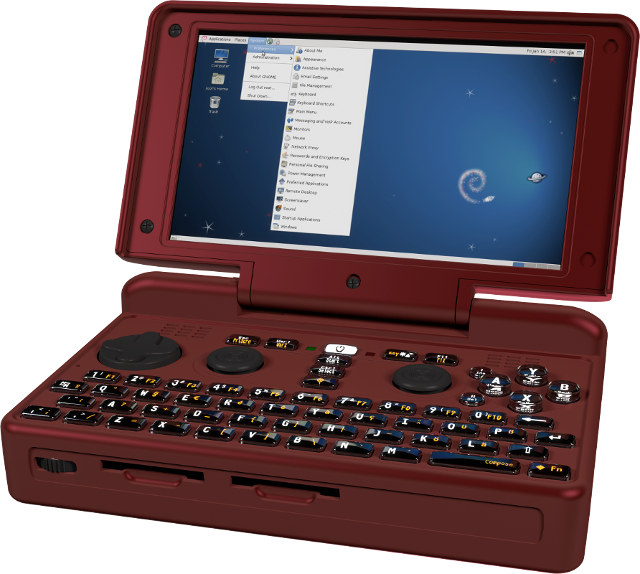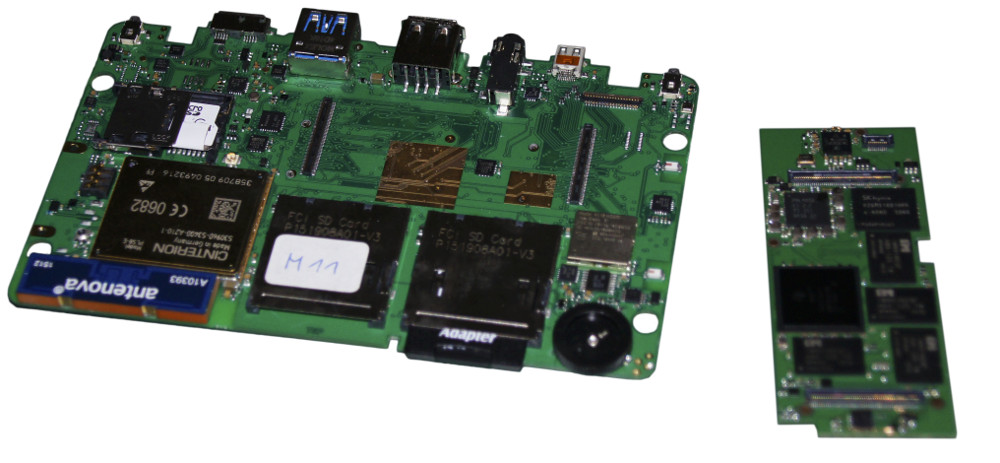The development of Pyra open source portable gaming console started in 2014, and after over two years of hard work, the developers are now ready to take pre-order of the Texas Instruments OMAP 5 powered device running Debian Linux.
 Pyra handheld specifications have changed a little bit since the announcement two years ago:
Pyra handheld specifications have changed a little bit since the announcement two years ago:
- SoC – Texas Instruments OMAP 5432 SoC with 2x ARM Cortex-A15 @ 1.7Ghz with NEON SIMD, 2x ARM Cortex-M4, Imagination Technologies PowerVR SGX544-MP2 GPU for 3D graphic, and Vivante GC320 GPU for 2D graphics
- System Memory – 2GB or 4GB RAM
- Storage – 32 GB eMMC flash, 2x SDXC card slot, 1x internal micro SDXC card slot
- Display – 720p 5″ LCD with resistive touchscreen
- Video Output – micro HDMI
- Audio I/O – High-quality speakers, analog volume wheel, headset port, built-in Mic
- Gaming controls – D-Pad, 4x shoulder buttons, 6x face buttons, 2x accurate analog controls with push-button
- Keyboard – Backlit QWERTY keyboard
- Connectivity – Dual band Wi-Fi 802.11 b/g/n and Bluetooth 4.1. Optional LTE and GPS module
- USB – 2x USB 2.0 host port (one usable as eSATA with adapter), 1x micro USB 3.0 port, 1x micro USB 2.0 for debugging and charging.
- Sensors – Accelerometer, gyroscope, etc.
- Misc – Fully configurable RGB-LEDs for notifications, vibration motor
- Battery – 6,000mAh, same as for Pandora. Battery life is expected to be the same or better as Pandora (10 hours), except for CPU intensive tasks
- Dimensions – 139 x 87 x 32 mm
So they’ve increased the battery capacity, added internal eMMC flash, reduced the display resolution to 720p, now offer two RAM options with either 2 or 4 GB memory, and a few other changes.

The internal design is comprised of the mainboard, a CPU module, and (not shown above) a display board. That means that if a more powerful CPU module is available later, you may be able to only replace the CPU module, while keeping the rest of the design. You’ll also be able to design your own better CPU module, since the Pyra will be open source hardware. As mentioned in the title and description the device runs the full desktop version of Debian Linux, and thanks to the micro HDMI port you could easily use it as a mini PC by connecting to a larger monitor, as well as a keyboard and mouse. More details about the hardware and software can be found in the Wiki.
So how much does this unique device sell for? You’ll have four options:
- Pyra Standard Edition, 2GB RAM: 500 Euros without VAT (=595 Euros incl. VAT)
- Pyra Standard Edition, 4GB RAM: 529,41 Euros without VAT (=630 Euros incl. VAT)
- Pyra Mobile Edition, 2GB RAM: 600 Euros without VAT (=714 Euros incl. VAT)
- Pyra Mobile Edition, 4GB RAM: 626,05 Euros without VAT (=745 Euros incl. VAT)
The Mobile Edition adds mobile Internet (3G/4G), GPS, and some extra sensors namely an altimeter, hygrometer, barometer, and compass. They do mention they are not sure yet the 4GB RAM with be produced, in which case you may have to settle for the 2GB version. You won’t need to pay the full price for pre-order, as they ask for a downpayment of 330 or 400 Euros for the pre-order, but they don’t have estimated delivery time for now.
More details about the Linux game console can be found on Pyra Handheld website.
Thanks to buZz for the tip.

Jean-Luc started CNX Software in 2010 as a part-time endeavor, before quitting his job as a software engineering manager, and starting to write daily news, and reviews full time later in 2011.
Support CNX Software! Donate via cryptocurrencies, become a Patron on Patreon, or purchase goods on Amazon or Aliexpress





